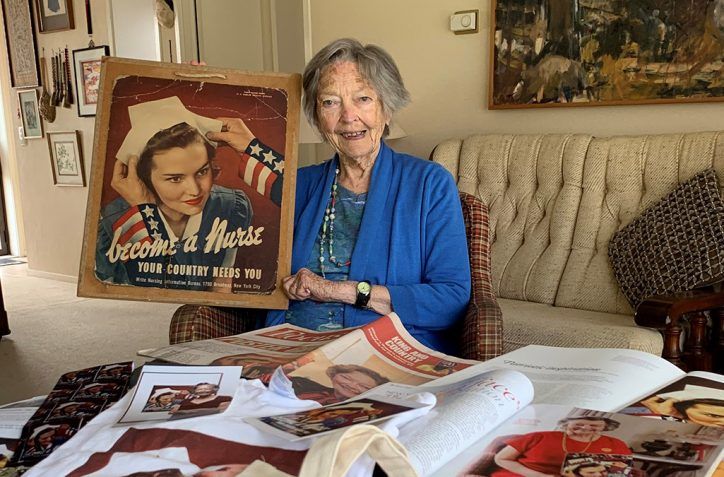Reflections of a poster girl and cultural icon

She’s been on everything from T-shirts, tote bags and men’s ties, to bumper stickers, fridge magnets, and stationery. The face of one of the world’s most renowned advertising campaigns, Weslee (Wes) D’Audney is a cultural icon.
Resident at Metlifecare’s Hibiscus Coast Village, the elegant 95 year old was propelled into the spotlight 79 years ago, when as a pre-med student and New York model she became the poster girl for America’s World War 2 recruitment efforts. Her image is said to have inspired 400,000 Americans to take up nursing and has been exhibited in the world’s leading museums from the Smithsonian Institution to the Australian National Maritime Museum.
It’s a funny feeling to be historic,” says Wes, who ended up in New Zealand in 1945 after marrying an RNZAF pilot in New York City. She has called Hibiscus Coast Village ‘home’ for the last 28 years.
It was such an insignificant part of my life – all I did was sit for two hours and have my picture taken – but somehow that propaganda poster has taken on a life of its own.”
After serving its purpose in the 1940s, the poster started reappearing around 2005, first spotted by Wes’s daughter Carol as she browsed the internet during a visit to Shanghai.
Says Carol, “Nostalgic images from the 40s and 50s suddenly became really popular and it has just snowballed from there.”
Since then, Wes has been bombarded by fan mail and autograph requests from all corners of the globe and her image has been splashed across over 200 items of memorabilia, including pendant necklaces embedded with Swarovski crystals, baby onesies and even Israeli postage stamps!
But there is so much more to this vibrant nonagenarian than a globally-recognised face. She’s a talented painter, an award-winning gardener, and a writer with numerous publications to her name (some of her books can be found in the New Zealand National Library).
Being a poster girl is not what I want to be remembered for,” explains Wes. “I didn’t work to achieve that – there are so many other things I’ve worked hard to achieve.”
First and foremost are her family – five children, six grandchildren, two step-grandchildren, five great-grandchildren and twins on the way. A career dedicated to working with multi-handicapped children comes in a close second.
My youngest son Bruce was multi-handicapped and we couldn’t find the right care for him. The only solution I could think of was to become a teacher of the deaf and teach him myself so at the age of 44 I went back to university.”
There she gained a Master of Science in Special Education and a Specialist in Education degree in Educational Administration before embarking on a rewarding, successful career teaching profoundly deaf and multi-handicapped kids. Among her career highlights were her directorship of two federal programmes for the early diagnosis and education of handicapped children and her role as a professor at a university medical centre.
These are the things that I’m truly proud of.”